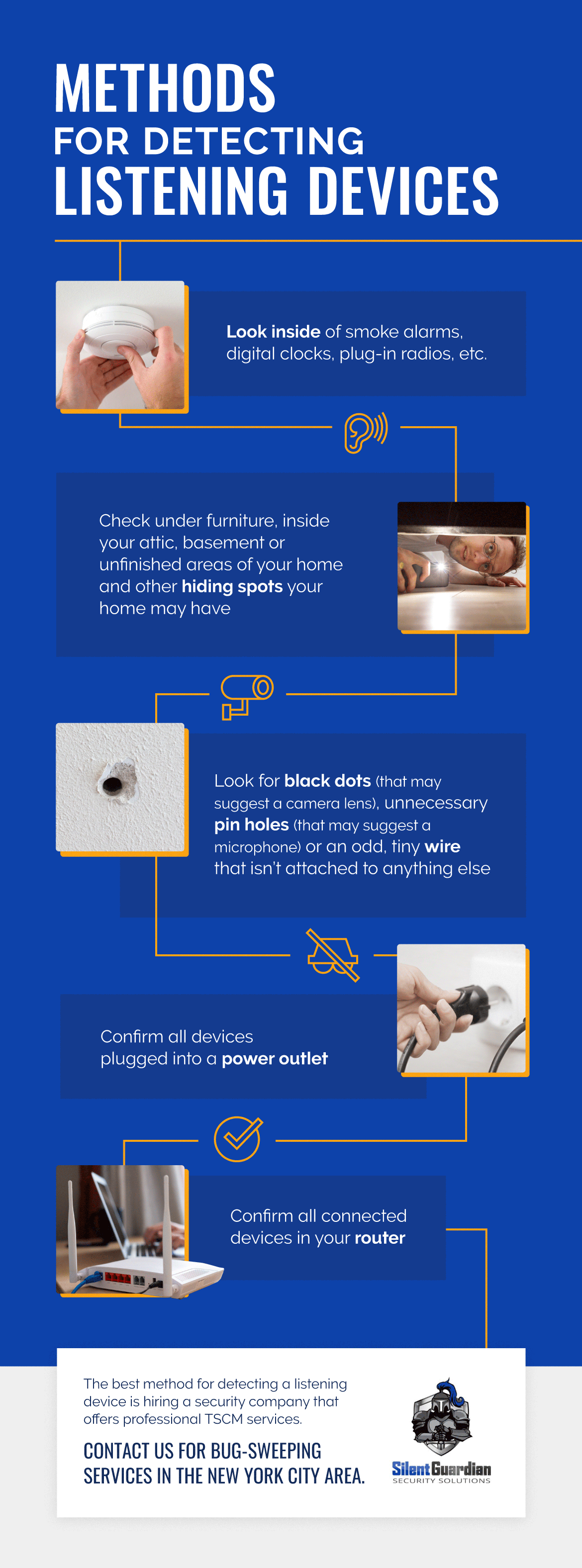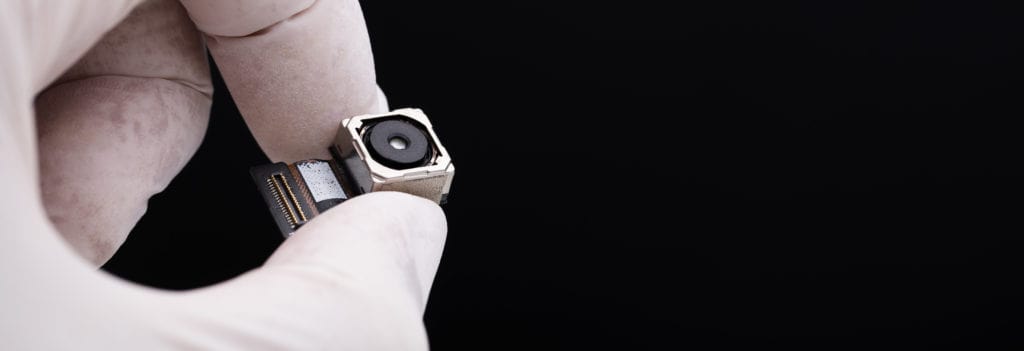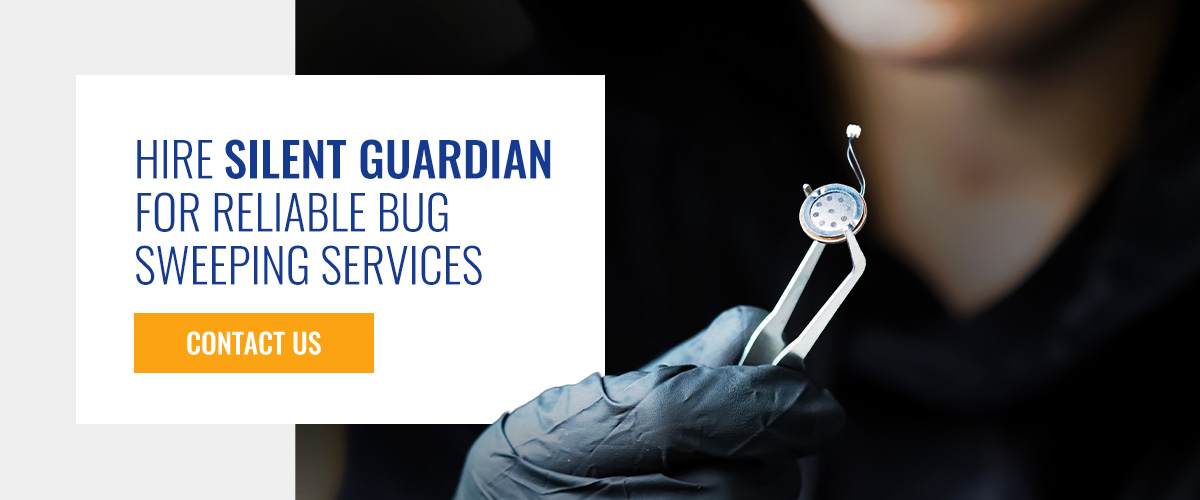Sep 2024
How Do Listening Devices Work?
We all know what listening devices are, but have you ever wondered how they work? In this article, we’ll answer the following questions about eavesdropping detection devices:
- How far away can listening devices hear a conversation?
- Do listening devices make noise?
- Can listening devices hear through walls?
- How do listening devices work?
- How do you detect listening devices?
People use these kinds of devices to hear conversations from a distance so that the people talking do not know someone else is listening to their private communications.
The police will often use listening devices to spy on certain suspects who they have reason to believe are involved in criminal activity. Companies use listening devices to spy on competing businesses and overhear confidential information. Because of this, it is extremely important for corporate offices to sweep the room where meetings are being held for listening devices and hidden cameras. Parents also use these products to ensure their children are cared for properly by a babysitter or a nanny. They can buy a listening device that records audio to hide in the home and listen to the recording later on.
How Far Away Can Listening Devices Hear a Conversation?
Depending on the type of listening device being used, some of these devices can allow someone to hear a conversation from 100 yards away, while others have a range of 300 yards.
Here are a few different listening devices that you can find:
- Cell phones: These devices look like cell phones but don’t function as phones — they perform as wireless transmitters and allow someone to spy on others inconspicuously.
- Long-distance sound receivers: These majorly include parabolic/laser microphone devices that detect sound vibrations using laser technology. Their sophisticated surveillance technology ensures users can eavesdrop from long distances without a chance of being exposed.
- Tiny listening devices that can hear through walls: These devices look like mini stethoscope microphones. When placed on the wall, they capture conversations or sounds occurring in the target room and convert them into clear audio you can use for evidential or related purposes. They’re also good for detecting pests hiding behind walls and water leakages in piping systems. You can plug them into a radio receiver/headset to listen to the recordings.
- Bionic ears: A bionic ear allows users with partial or complete hearing impairment to hear voices or conversations within a 100-yard range. Depending on a user’s impairment level, amplifier systems can be used to amplify the audio.
- Digital voice recorders: There are numerous options, but the most common ones include digital pen recording devices, phone recorders powered by USB and wearable voice recording devices. Most of these are used for recording audio in studios and nature and during fun moments for leisure and good memories.
Do Listening Devices Make Noise?
Technically, they do not make noise the human ear can pick up, making it hard to detect a listening device in your home or office. However, there are slight noises someone can try to hear if they believe another person is eavesdropping on their cell phone conversations.
If there is an audio bug in a phone, use headphones instead of using the phone’s speaker to listen while talking on the phone. Why? If the phone has a listening device in it, you will hear a slight static noise like radio stations do when they are not tuned in properly.
Otherwise, most listening devices cannot be detected by listening for unusual sounds or static. They are designed to be discreet so that no one knows someone else is tuning in to their private conversations. If you suspect your home or office has been bugged, the best way to confirm the presence of a listening device is to bring in a professional with the equipment needed to detect what the human ear can’t.
Can Listening Devices Hear Through Walls?
Yes, listening devices have a high-frequency range that can hear conversations through the walls of an office building or home, whether made from brick, concrete, sheetrock, or other materials. If the microphone is sensitive enough, an audio surveillance device can even allow someone to hear whispering in the adjacent room. To keep your corporation’s confidential information safe, consider building a Sensitive Compartmented Information Facility (SCIF) room.
How Do Listening Devices Work?
Listening devices are very tiny and have even tinier microphones inside them. Since they’re so small, they’re usually overlooked by most people and can be hidden in various places. Some of these products are designed to look like everyday items, such as pens, which makes them discreet and easy to plant in any meeting room or household.
Listening devices or listening bugs come in two types — wired and wireless options. The wired type connects to a recording or storage device, so it doesn’t need to send a signal or store the data in its system. The bug transmits the data to the connected storage device.
As for the latest and most common listening bug type — wireless devices — the process is a little complicated depending on the device. The most basic ones have some sort of internal storage where data is kept. Individuals can place them strategically where the target can be recorded, then pick them up later to retrieve the sound.
The most advanced options come with Wi-Fi, Bluetooth or radio wave capabilities, allowing them to transmit data to a nearby computer for real-time access. Most wireless listening devices record sound within a 300- to 900-foot range.
People who are considering buying wireless listening devices will have two recording options:
- Continuous recorder: These types record continuously, provided they’re powered on. Once you pick one up, you can go through the entire file to find useful audible sounds and discard the rest.
- Voice-activated recorder (VA): These devices only record audio when they detect sound, which could be a voice or any loud noise in the environment.
How Do You Detect Listening Devices?
Detecting listening devices is tricky, especially as technology continues to advance and these devices shrink in size, making them harder to spot with the human eye. They can also be designed to look like everyday items, such as pens and cell phones, so people would not consider the listening devices suspicious or might not know they are in their office, car or elsewhere.
If you’re suspicious there could be some secret listening devices, here are a few tips on detecting them:
- Check for unusual objects or devices: If you notice objects like pens, picture frames or teddy bears stationed in a strange way or position, you might want to give them a closer look.
- Check the source of strange buzzing sounds: You might hear a slight buzzing or a small clicking sound whose source isn’t clear. Check to see if a recording gadget is hidden close by.
- Look inside smoke alarms and other similar hiding spots: If conducting a detailed search, look inside possible hideouts like smoke alarms and similar devices.
- Look out for loose wires: If you notice an odd, tiny wire that’s not attached to anything else, follow it through to the source. It could be from a hidden listening device.
- Inspect light fixtures: Light fixtures are common culprits for hiding listening devices, as they’re strategically located in rooms and can easily accommodate electrical connections.

Tools for Detecting Listening Devices on Today’s Market
There are no 100% effective tools for detecting listening devices, but these can be efficient for guiding you through your search:
- RF detectors: Detectors are useful for scanning radio frequencies used to transmit a microphone or a hidden camera.
- Digital cameras: These can help search for infrared lights, which are commonly used in spy cameras.
- Wi-Fi: Some listening devices connect to the Internet. If you notice a foreign device with a sell-out name like “MyCam” or “IPCam” whose Wi-Fi signal is strong, the device is probably close by.
Hire Silent Guardian for Reliable Bug Sweeping Services
The best method for detecting a listening device though is hiring a security company that offers professional TSCM services. This includes sweeping for bugs with high-tech equipment that can find even the smallest of listening devices. Contact Silent Guardian Security for bug-sweeping services in the New York City area.

